-
Content Count
1358 -
Joined
-
Last visited
Posts posted by LEGO Historian
-
-
Wow... 9 year old thread... but still worth reopening...
When TLG introduced the new 2x2 (reinforced underside) macaroni brick in 2008....
https://www.bricklink.com/v2/catalog/catalogitem.page?P=85080#T=C
It rendered the old hollow bottom (1955-2014) obsolete...
https://www.bricklink.com/v2/catalog/catalogitem.page?P=3063#T=C
So the new macaroni bricks can no longer be used to create this type of staggered macaroni brick build...
https://brickset.com/sets/801-3/Space-Rocket
I assume that the old staggered macaroni built builds were considered illegal in today's definitions... but I remember that old build type was also used in older versions of the Jefferson Memorial columns in Legoland Billund...

-
Yes, since minifigures have become the "crown jewel" of many LEGO collectors (not all), there are a preponderance of fake minifigure parts, or real minifigure parts with fake aftermarket printing. Just look at the Mr. Gold CMF of 2013... there were 5000 genuine figs produced, but because they sell for thousands, the number of fake Mr. Gold's outnumber real ones by 20 to 1 (at least). Fake ones sell on Ebay, but are listed as fakes, mostly for $2 to $5 each. Many of these (Chinese sourced) fakes even have a LEGO logo, but are fake elements. What makes it bad is that fake Mr. Gold looks often nicer than the real Mr. Gold. So with this item, one would be foolish to purchase one without the certificate identifying it as "xxxx of 5000".
Fake LEGO items have been around for at least 15 years, when someone made fake Maersk blue construction helmets (also sourced from China), which were only found in the 1980 era 1651 Maersk Line Container Truck, and which sold for hundreds of dollars. These fake Maersk helmets, weren't even the right shade of blue... they were more of a teal blue than a Maersk blue. The reason for making this fake helmet dried up in 2011, when the 10129 Maersk Container Train was introduced (with 3 minifigs with Maerskn helmets), when they started selling for as little as $2. The new helmets have LEGO on the inside, the real old 1980 helmets only have a mold number on the inside (only 1 for sale on BL for $75).
In my Unofficial LEGO Sets/Parts Collectors Guide, I have a chapter for Counterfeit LEGO parts/sets. However besides about 1/2 dozen minifigs (including Mr. Gold, and the Maersk helmet) the potential fake minifigs out in the wild are too numerous to mention, and I stick mainly with fake set boxes, 10179 Millennium Falcon fake radar dishes, and a lot of other rare LEGO parts that have been faked.
For those of you who have my digital collectors guide, new (free to current owners) updates will be out at the end of the year.

-
I believe Leviani got all the answers he needed from Brickset, Facebook, and Flickr.
That baseplate was produced by Swedish plastics maker GEAS KONSTHARTS of Gislaved Sweden. They produced a Swedish licensed version of Automatic Binding Bricks from 1950-53, and a separate product called PRIMA from 1953-55. Starting in March 1955 LEGO sales began via offices in Lerum Sweden, with the first LEGO sets produced from parts produced at a Norwegian LEGO subsidiary (a co-owned company called A/S Norske LEGIO, that TLG owned along side Oslo plastics maker Svein Strømberg & Co.). It gets very complicated...

As for the BAGERI Swedish baker sign... there are many LEGO brick signs from the 1955-75 era that are not listed in Bricklink.
Here is a copy of my Unofficial LEGO Set/Parts Collectors Guide, Chapter 48 - Printed and Painted LEGO... showing many more LEGO signs that are not in Bricklink...
https://www.1000steine.de/brickset/miscellaneous/Lego Chapter 48 Vol2.pdf
-
First of all... pre-Norman church would translate to "Saxon church" to me. English Saxon church architecture does not generally have rounded apses, as your image shows. That looks like a later Norman addition to an earlier church.
Here is a LEGO ideas book page of a Saxon church, showing all squared sides....

If your intent is to keep it pure Saxon, then eliminate rounded surfaces, which would be later Norman or medieval additions.
-
The 070 Basic set was produced from 1967 until 1972. However, there is no known online parts inventory... at least not in Bricklink nor Peeron.
-
Funny that this discussion about trans-clear bricks from 7 years ago got re-opened.
Recently on Brickset, I started a discussion on the latest plastic now used for trans-clear LEGO elements... called MABS... Methyl methacrylate-acrylonitrile-butadiene-styrene. Here is the discussion:
-
Well stated Thorsten...
Did some of you miss the announcement that LEGO was going to start labeling all sets geared for adults with the "18+" label, so that retailers can follow directions to put all of these sets together into one section just for adult collectors?
Not all adult LEGO builders are active AFOLs... so this will help them out as well as AFOLs.
-
14 hours ago, Mummeldjur said:Thanks for all the replies! The image is part of a slideshow in an online article telling the story of the lego company. Interesting to see the edited version in the catalogs! Wonder if i should try to contact the author or something...
Just out of curiosity... is there a link to that slideshow on the LEGO company? Thanks!!

-
The LEGO Group has been "modifying" photographic images to make colorful LEGO images all the way back to 1953.
Here is an early 1953 LEGO photograph showing Godtfred Kirk Christiansen's 3 children... Kjeld, Gunhild, and young Hanne.

This 1953 image was colorized and cropped for the basic set box tops of 1953-55 (of Denmark, Norway and Sweden)....

TLG has been doing this type of artwork changes during the early years of LEGO. For those of you who have my Unofficial LEGO Sets/Parts Collectors Guide... (computer desktop download), there is an entire chapter devoted to modified artwork. (Note: for those of you waiting for your free upgrade to 2020, I will have it ready in 1st quarter 2021... with over 500 higher resolution older images, as well as thousands of images to cover the years 2000-2020.)
-
LEGO retailer display models have always been glued, since the first ones shown at LEGO toy retailers in 1955. WITHOUT EXCEPTION they have always been glued. There are even yearly glued display model catalogs. In my Unofficial LEGO Sets/Parts Collectors Guide, there is an entire huge chapter devoted to older glued retailer models. Here are some older examples... from the 1960s and 1970s, but my guide chapter has even modern models. These are mainly from 2 of my LEGO friends who buy and restore old glued retailer models... Henk (Netherlands) and Chris (UK)...
1959-60 Castle glued model...

Very large glued model of Schloss Johanisburg in Aschaffenburg Germany (summer home of the Archbishops of Mainz)...

Model of an existing half timbered house in Hildesheim Germany...

A 1960s glued model of an office tower...
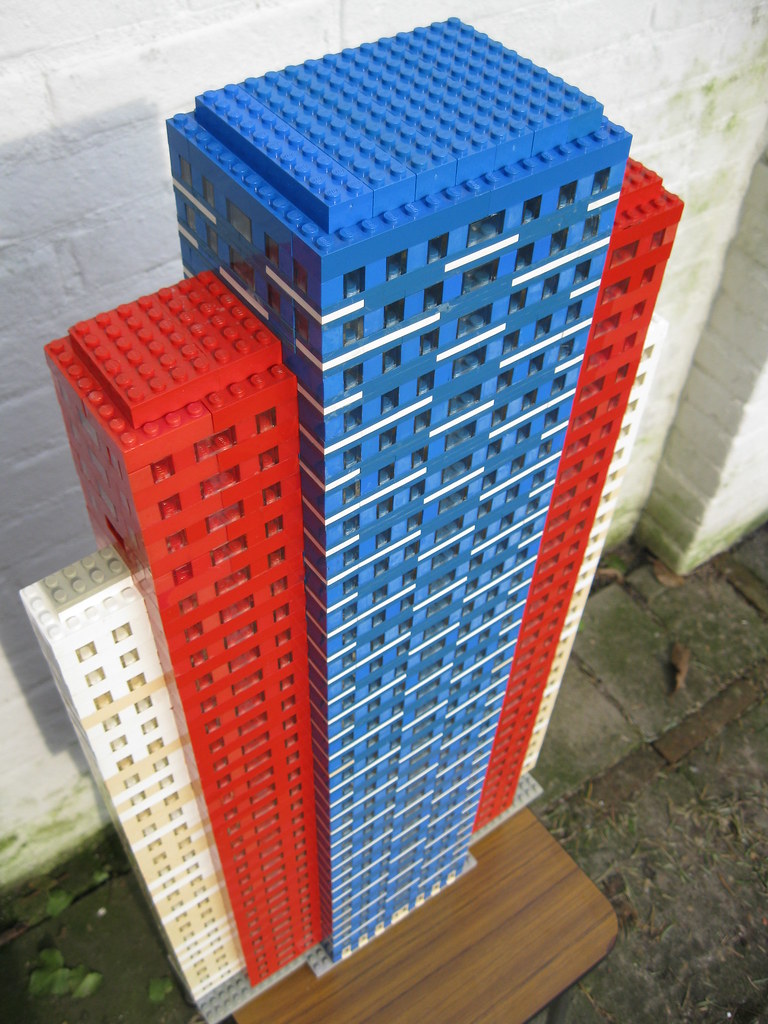
A 1963 model of a Swiss chalet, showing the new (to 1963) small plates...
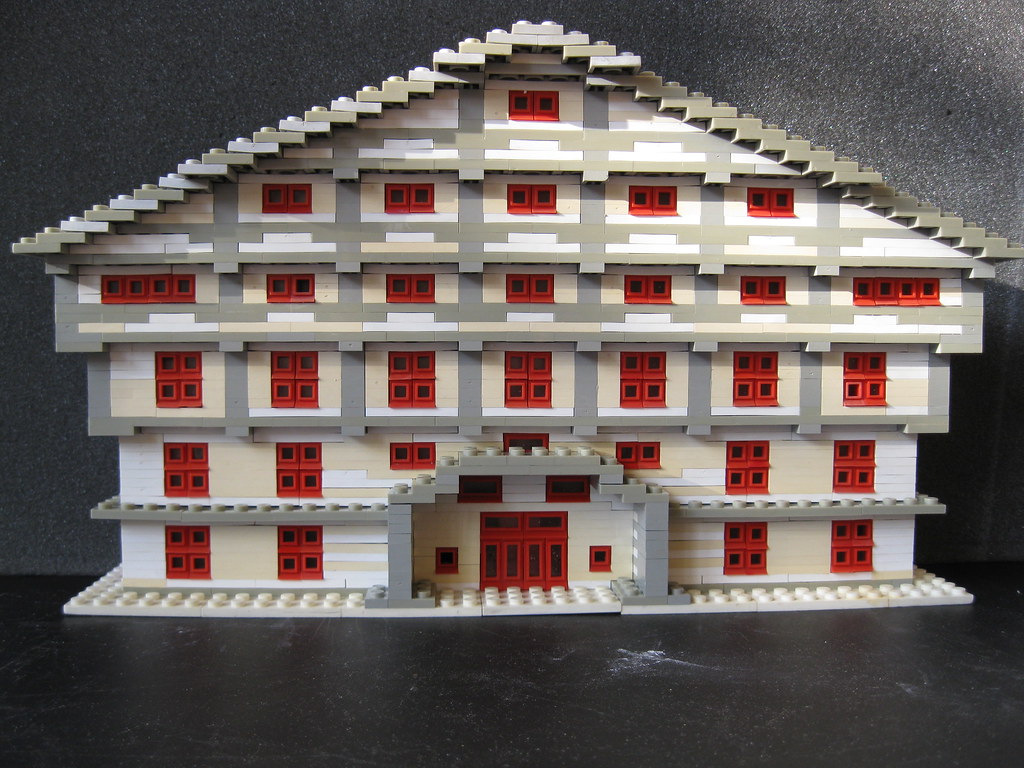
A 1959 cruise ship model...
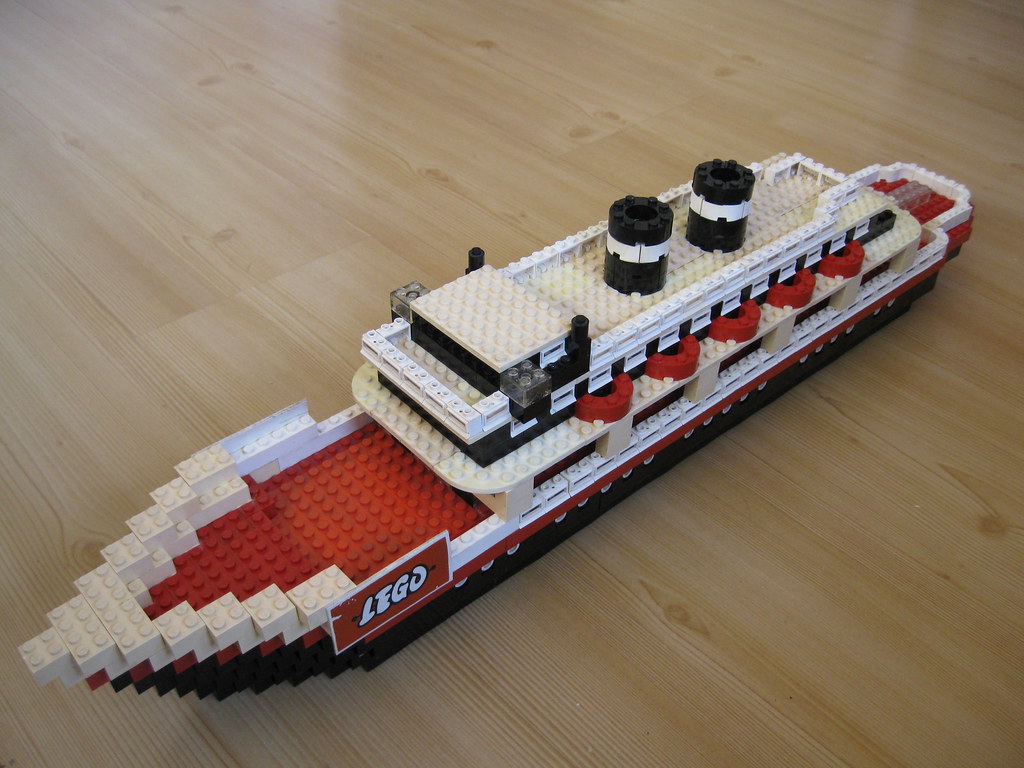
An 1960 model of the Elizabeth Tower (Big Ben) in London...

A 1976 historic photo of LEGO owner Godtfred Kirk Chrisitiansen showing Prince Claus of Netherlands a model of the Queen and Princes summer palace in the Netherlands...

A late 1960s model of a LEGO medieval house using LEGO fence pieces as windows...

A 1959 photo of glued "LEGO Gnomes" marching out of the LEGO factory in Billund...

A mid 1970s group of Homemaker glued display models...

A 1980s glued display model of an English manor house...

A 1960s group of English half timbered glued display models...

A circa 1970 glued display model of a fantasy castle...

A 1960s glued display model of an aircraft carrier and a large cruise ship...

A 1980s glued display streetscape of an English street, with a snack bar in frront...

Besides these and many dozens more glued display models over the last 60 years, my computer desktop Unofficial LEGO Sets/Parts Collectors Guide chapter on glued retailer models also has images of glued retailer catalogs, retailer order forms, and other related items.
-
If you have more modern sets, then Bricklink is the way to go... However, for sets before 1980 that becomes problematic, since many older sets have "N/A" in the Bricklink price history field, thus making it useless for determining the value of older sets.
In my Unofficial LEGO Sets/Parts Collectors Guide I have a 400 page "Insurance Pricelist" that covers all sets from 1949-80. This will help out for filling in the blanks for older LEGO sets. My guide has price info that any normal "collectible" guide would have... for 4 conditions: VG EX MIB MISB. The VG value would be for a set without the box. My collectors guide Insurance Pricelist has a 400 page document in US dollars and also a separate one in EUROs.
-
Robert Pattinson, who became a Hollywood star when he starred as the love starved vampire Edward Cullen in the 5 movie Twilight Saga back in 2008-2012... will be the new Batman in the upcoming THE BATMAN movie due out in October 2021 (supposedly a trilogy of 3 movies is planned). He played a great brooding vampire in Twilight (and the other 4 movies, which grossed as much as all the Jurassic Park movies). It will be interesting to see his minifigure when the next LEGO Batman movie comes out...
-
Sorry I can't be of any help... LEGO Club magazines is outside of my range of study.
Of my nearly 35,000 LEGO images (I just had to move them all to a new computer, so I was shocked I had that many)... fewer than 50 are LEGO magazine related, and most of those are for the late 50s and early 60s.
I also have the cover pages for comics that are related to sets, but nothing related to the LEGO Club magazines.

-
This whole thread is kind of pointless....
Throughout LEGO history until the minfigs came out in 1978... other ethnic groups, such as Africans in native garb, or Middle Easterner Muslims in Birqa's and others were represented in LEGO builds, such as these alternative builds in 1960s model sets 316, 324, 321, and 317.
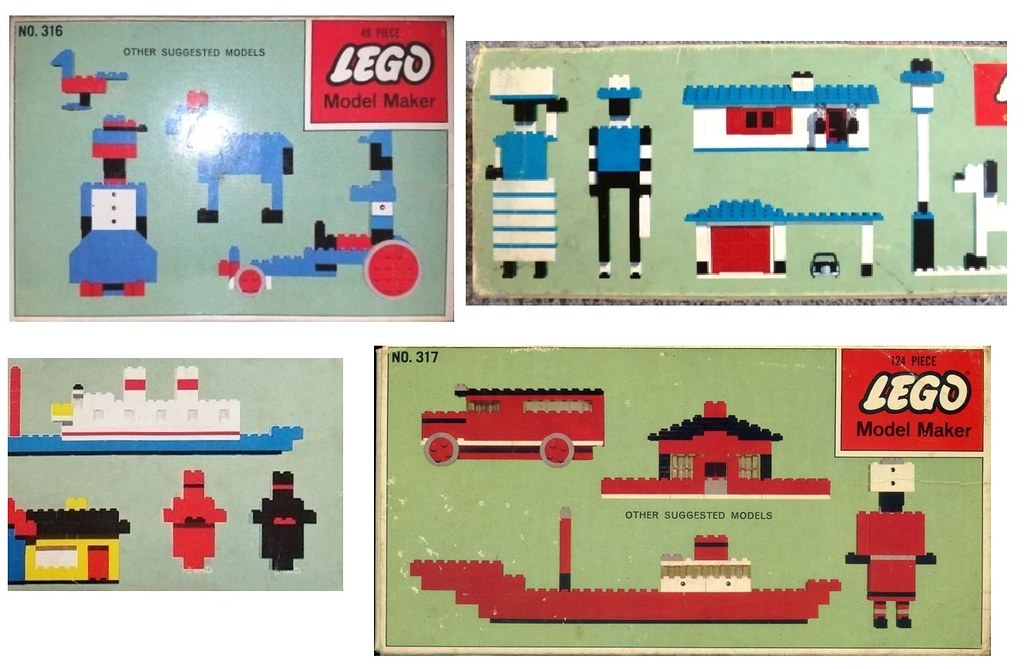
-
On 6/6/2020 at 10:52 AM, Ron Dayes said:Thats actually incorrect.
"TAN" number code 2 in the color palette was officially introduced in 1957 and the minifig came out 20 years later in 1978!
They could have made tan minifigs, in fact, there is tan based figurines for the old town layouts. But they chose not to, to avoid the skin color political aspects at the time.
It was stated in several interviews aswell. Yellow is a "happy" colour. As it was also used for the first castle instead of a militaristic grey...
But knowing the rather limited color palette used in sets at that time, it might seem that they didnt have those colors - but in fact, they did have a huge array, just never used them because it was quite pricey and not reall necessary back in a day.But yeah, TLG doesnt need to change anything atm. agreed.
That is also actually incorrect... tan was first used in Modulex (not part of the LEGO System of Play) in 1963, and it first came out in 1968 in small plates in LEGOLAND Denmark... so the LEGO model shops were the first to have a supply of tan parts. In 1985 I saw a huge model of the Brussels Hotel de Ville (City Hall) made of tan and dark gray bricks... but it was not available in any LEGO set until 1998.
When people say that tan or flesh tones came out in the 1950s, that was tan or flesh colored PAINT, not bricks. Here are some of the LEGO cyclists that were sold in the 270/1270 parts pack of 1956-65.... (images from my Unofficial LEGO Sets/Parts Collectors Guide)...


Tan bricks/plates were never part of any LEGO set until the 1990s. Sure TLG could have produced tan parts at any time they chose, and I am sure that some designers really wanted to use tan in their building models (just like they wanted to use gray, dark gray or green bricks)... but TLG was very stingy in their use of their color palette in those days. With the exception of the gray (and first Maersk blue) bricks in the 1974 #1650 Maersk Container Ship, gray was only used for plates and the 10x20 baseplates until the 1980s, dark gray was not used at all until some castle/pirate sets had weapons and parts in that color, and green was not used for bricks for many decades after first being introduced in 10x20 baseplates and (1963-66 small Samsonite LEGO plates).
LEGO was very odd about the release of colors in their color palette until starting in the 1990s... and since 2000 the color palette has exploded into more colors than they really need. Very strange.
As for the first minifigs being yellow... TLG just followed their earlier tradition of using yellow in the maxifigs heads, and minifig stiff heads (with the single exception of both being the 215 Red Indians set).
All the odd things that TLG did in the early years I just call it "LEGO Mayhem"... and leave it at that... there was no rhyme or reason to a lot of what LEGO did back in the early days....

-
After all the kerfuffle over pink LEGO and the Friends sets among feminists, and the protests over making Shell LEGO sets by environmentalists... TLG probably decided to be ahead of the curve... and remove police themed items from their selection for a while, until this all simmers down. Can't blame them for that. As for any LEGO sets in inventory or those that perhaps might be returned to TLG by retailers... they'll just stick them into trash compactors and shred them to oblivion.... Hehehe... just kidding...

We all know that TLG NEVER throws anything away.... they'll be back when things cool down (or maybe relegated to Shop-At-Home). The end result may be fewer of these sets produced, with short production runs... but I don't see Police sets (a staple of LEGO Town/City since the 1970s) being eliminated completely.
-
Um.... I don't know if I follow you... but most LEGO set names (if that is truly what you are referring to)... they are meant to entice 10 year olds. I was just adding the Pharaoh's Quest sets to my LEGO collectors guide... and I was numbed by some of the "eye rolling" names they used there such as 7307 "Flying Mummy Attack".... before coming back to reality and realizing that these descriptives were for children.
Now if you are referring using simple nouns and verbs to describe LEGO... then yes... that will be a snooze as far as naming MOCs go.
I try to capitalize on naming MOCs in reference to historical or architectural terms for names (even modern style MOCs)... such as this MOC I built 20 years ago, based on a TLG design in a 1960 LEGO Idea Book... but I built it out into 3 dimensions, and gave it a powerful period name...
I call this MOC (in honor of the LEGO founding family).... "Christiansenborg Castle... in the style of the 16th Century Scandinavian Renaissance".

-
I received a nice feedback from a French quarantined LEGO collector who just bought my guide this week....
"Hello Gary,I love your book ! Can't describe the pleasure and memories it brings to me especially in these times of confinement !!!And if ever you need help on anything for your next edition you're working on, be it LEGO related or computer wise or anything really, just let me know !Kind regards and congratulations again !David Lefebvre" -
In these trying times during the Coronavirus, a lot of people are bored and have little to do. My 2800 page Unofficial LEGO Sets/Parts Collectors Guide was purchased in the last month by 10 Italians and 3 Frenchmen... all bored from being quarantined... many have told me they really enjoy going thru thousands of pages of reading and learning. No shipping, no Customs... just a 10 minute 668MB download!!
As one of the leading authorities on LEGO outside of TLG (this year will be my 60th year of collecting, since I was 7), I wrote a 2800 page Unofficial LEGO Sets/Parts Collectors Guide, which used to be available on DVD, but now is only a 668MB computer desktop download, available without shipping or customs... just a a series of 84 PDF files that you download (a Table of Contents, 73 chapters, and 4 appendices
I go all the way back to year 1 of the first LEGO bricks... 1949. For those of you who wish to see many of the rare and unique items in the guide (many of which are not even in the LEGO Vault... you can check out my Flicrk pages....
https://www.flickr.com/photos/82930629@N08/
https://www.flickr.com/photos/istokg/
Alsoi included in my computer desktop online guide is a pre-1980 pricelist of all LEGO sets... a 400 page guide in US dollars, and 400 page guide in Euros. Those sets since 1980 are more easy to value with them being more common on Bricklink and Ebay.
I have been working since 2006 in collecting data and images from the Billund Archives, as well as 150 friends from around the world.
My guide costs $29.95 US via Paypal (for your protection).
You can order it here (I ship it out personally), and in addition I send you another free LEGO guide on old plastic and wooden LEGO cars (1952-57).
http://legocollectorsguide.weebly.com/
Also, if you want to know what can possiby take 73 chapters.... here is a writeup by Huw Millington of Brickset.... including the 73 chapters and many subchapters.
https://brickset.com/article/3064/unofficial-lego-sets-parts-collectors-guide-free-chapter!
Here is what a sample chapter of my guide looks like... an in depth look at the hundreds of Printed LEGO bricks from 1955-80, in a mind boggling number of colors... these are listed by language and country.... (although most chapters are on LEGO sets... by the thousands.
https://www.1000steine.de/brickset/miscellaneous/Lego Chapter 48 Vol2.pdf
And finally... here are some of my favorite images from the guide....
1949 LEGO set 700/2 Automatic Binding Bricks...

1957 Swedish Institutional Wooden Box set... sold to schools, beauty parlors and barber shops (to keep the kids busy while parents are getting their hair done....

1963 USA Samsonite LEGO glued display model of the British Houses of Parliament.....

Only known example of a 1958 306 VW Garage set... except this Norwegian set substituted rare Opel Kapitän cars, instead of the VW Beetles that usually are in this set.
In 1957 Norway made a few of these very rare Opels (fewer than 25 known)... and an inside factory worker put this one together with the rare Opels... which sell for 4000 Euros each in excellent condition, making this set worth about 8000-9000 Euros.


10 1980s Fabuland blister packs... they decided at the last minute not to release them... and ended up sending the few ones they did produce to 2 toystores near Copenhagen. These are not in any online database, and are extremely rare.
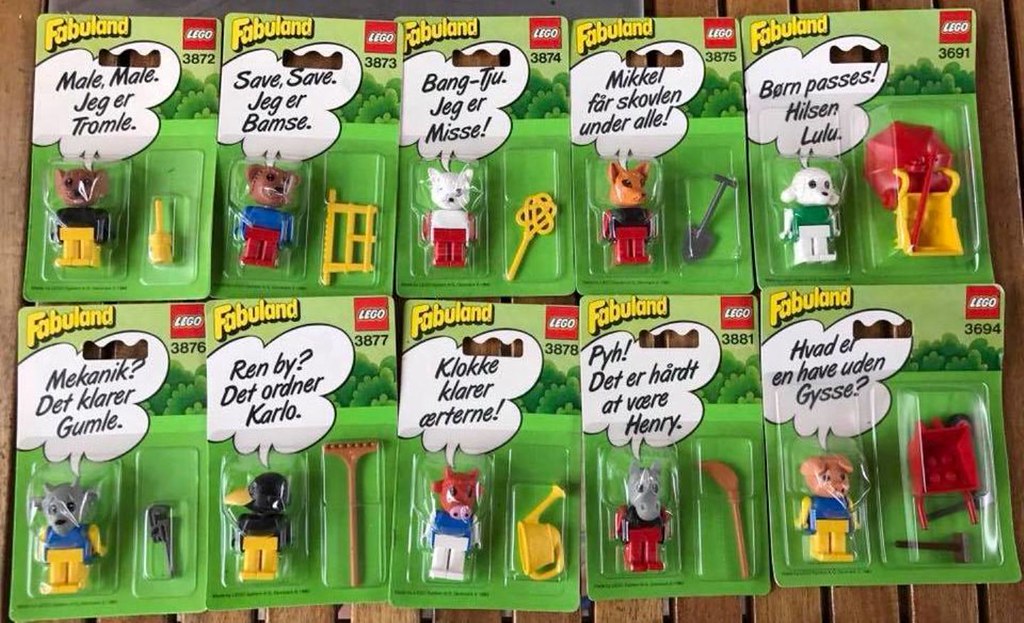
Like Russian nesting dolls... TLG made many differen sizes of LEGO spare parts packs in the 1960s...

The only known example of a 1309 Norwegian Esso Garage Set. The Billund Archives have no info on this Norway produced set...

A close-up of the only known Norway 1309 Esso Garage...

The very first LEGO catalog type leaflet of 1949... including the first sets, and the first known LEGO model (large building) is of the LEGO wooden toy warehouse... which burned down on 4 Feb. 1960...

One last thing.... anyone who already owns (or buys) this guide... will get a free end of 2020 upgrade to my expanded 4500 page computer desktop guide... that will include all LEGO sets up to 2020.... FREE!!
-
What I think will hurt LEGO bricks is TLGs idea of making bricks biodegradable... which might just start happening before they eventually hit the landfill.

Old pre-1963 Cellulose Acetate bricks have a tendency to warp over time... which is why ABS replaced them. But for some odd reason I have an old CA set that has kept its' shape for 60 years. Must have remained in perfect climate over the last 6 decades.
-
1 hour ago, Brandon Pea said:I have bricks from the 90s that are still in good condition.
And I from the 1960s (unwarped Cellulose Acetate)... but I found that the Homemaker sets of the 1970s, even when kept in a dark dry basement for decades, have deteriorated in so many white bricks turning beige. I think that the minfigures from China (mainly CMFs) are going to age badly... due to poorer quality controls (possibly lesser grade of plastic than used in Europe).
Your good condition LEGO parts will likely stay in great shape for decades... but over the long haul... all plastic has issues... eventually...

-
On 3/18/2020 at 3:09 PM, Brandon Pea said:I keep my minifigures and bricks in good condition. So these types of issues NEVER happen to me.
Just wait.... even the best kept plastic deteriorates....
-
This is the downside to buying a set today... ripping it open and tossing the box out without a second thought.
Collectors of sets from the 1970s and earlier treasure their boxes, and readily have them at the ready in case they want to flip them over and build an alternative model.
FYI, the first year that TLG introduced alternate models was 1960.
Well anyway... this is a good idea for modern LEGO collectors who don't have room to store their boxes.

-
Who would have thought I would be able to reopen a 7 year old topic...

Just came across a 1962 image of the introduction of LEGO wheels... that showed a display window.
And in that display there is (in front of the large ship)... a retailer display model of the Villy Thomsen Truck... using just old LEGO bricks and (new) LEGO white wheels. (Note: LEGO wheels were introduced in 1962 in white rubber, and in 1963 TLG switched to gray rubber, until 1968... when black LEGO wheels were introduced for the first time!)
Sadly we don't have a better image of that truck, but it has all the characteistics of the 4000008 Villy Thomsen Truck. This means that glued dispay models of this truck may exist. I have several European friends that collect and restore 1950s, 1960s and 1970s LEGO glued retailer display models.



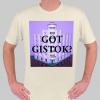
Lego myths and urban legends
in General LEGO Discussion
Posted · Edited by LEGO Historian
Haven't been around in a long time... still expanding and now rewriting my (soon to be 4000 page) digital LEGO guide...
But in the LEGO color discussion... TLG didn't make gray and green bricks for several reasons. One was they were weirdly stingy about producing a lot of different LEGO colors in bricks for decades. When the tube bottom bricks were introduced in 1958, LEGO bricks/plates were only found in red, white, blue, yellow, clear (and starting in 1961 (EU), and 1963 (UK/AUS, USA/Canada)) black bricks.
Also gray plates were introduced starting in EU in late 1962, in USA/Canada in 1963, and UK/Australia in 1964. Green plates were introduced in USA/Canada in 1963, and elsewhere much later.
The first gray bricks were found in the 1974 introduced 1650 Maersk Line Container Ship, and in regular sets (in about a dozen sizes) in the 722 Universal Building Set in 1980, as well as a few in (starting in 1979) Space sets. When the 375/383 first Castle sets of 1978 were introduced, they were not intended to be the beginning of a LEGO System... just a pair of sets in the parts colors that were available. Had these sets been introduced 2 years late (1980), they likely would have been gray. When the actual LEGO Castle System was introduced in 1984... gray became the color of choice. So if TLG was worried about gray being used for war toys by children, that worry was pretty much over by 1980 (of course after the yellow castle introduction).
The reason for using yellow to represent minifigure heads had its' origins in the mid 1960s, when yellow was the best color suited for LEGO built figures, such as those in the 905 Doll Set (USA/Canada only), and the 321 Clown Set (Denmark, Norway and Japan only)...
https://www.bricklink.com/v2/catalog/catalogitem.page?S=905-1#T=S&O={"iconly":0}
https://www.bricklink.com/v2/catalog/catalogitem.page?S=321-1#T=S&O={"iconly":0}
Also, this is unknown to most LEGO collectors, but the introduction of black bricks in the 1960s, made for some "alternate builds" of many of the 316-324 sets of the mid 1960s, as African figures...
TLG was very stingy in creating new colors for some very odd reason. They made dark gray, tan, and Maersk blue bricks for the model shops, but not for general sets until much later. In 1985 I saw a model at a Detroit KMART of a very large model of Brussels Gothic City Hall (Hotel de Ville) using ONLY tan and old dark gray colors. I became angry at the time, because they were being dishonest to kids of that era, of what could be built with LEGO colors that was actually available to the public. And it wasn't until the 1990s that other color bricks started being produced for sets. And since 2000 we started having an absurdly large number of LEGO colors. It's almost as though TLG was atoning for their lack of colors stinginess of the 1960s-1990s.